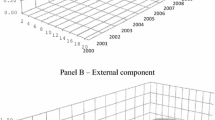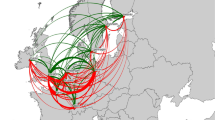Abstract
In this paper we study the direct and indirect contributions of firms to the co-movements between Italian business cycle and those of the 10 main trading partners. In doing so, we follow the approach developed by di Giovanni et al. (Am Econ Rev 108(1): 82–108, 2018) considering the 2005–2017 period, during which Italian economy experienced two different crises. Moreover, we propose a refinement in the estimation methodology originally used in the related literature by applying fractional response models for panel data, in order to take into account the bounded nature of data. Our findings show that firms’ trade linkages largely prevail over productive ones to explain the correlation between Italian firms’ value added and trading partners GDP growth. Furthermore, in presence of a small group of internationalized firms and a large group of small and not internationalized firms, the Italian business cycle correlation is mainly explained by the former group, because of both their direct links and indirect activation effects on the rest of the system. Our empirical approach also shows that using a linear FE estimator would result in a biased estimation of both indirect and direct effects.
Similar content being viewed by others
Notes
In the period 2010–2016, the correlation of Italian GDP growth rates with each one of 10 main trading partners decreased with respect the period 2005–2009.
Theoretical and empirical literature has widely analyzed these issues for decades. Here we can just limit to recall some of main seminal works: Stock and Watson (1999) verified the empirical relationship, in the postwar US, between the aggregate business cycle and various macroeconomic variables, such as production, interest rates, prices, productivity, sectoral employment, investment, income, and consumption; Kydland and Prescott (1982) pointed out the investment and capital accumulation responses in real business- cycle models; Frankel and Rose (1998) investigated the relationship between international trade patterns and international business cycle correlations; Bernanke et al (1999) highlighted the role of credit market frictions facing firms, households, or banks; Friedman and Schwartz (1971) analyzed the consequences of monetary policy.
The application of the granularity approach to the study of the microeconomic foundation of Italian business cycle is still very rare. To the best of our knowledge, so far it has been applied only to test the granular hypothesis on TFP volatility (Gnocato and Rondinelli 2018).
di Giovanni et al. (2020) analyze the micro-foundations of international transmission of business cycle shocks for French economy.
We are referring to firms with at least 1 person employed and positive value added. See paragraph 2.
The four classes of internationalized firms are not mutually exclusive.
The transition from a variable that varies between -1 and + 1 to one that varies between 0 and 1 takes place in two distinct steps. First, we translate the correlation index by adding + 1 to its range of variation. In this way we do not alter its distribution. Secondly, we rescale our new variable (now ranging between 0 and + 2) in a variable ranging between 0 and 1, again without altering its distribution. In doing so we follow the Studer and Wilkemann (2017)’s methodology. They propose an alternative approach for estimating the effects of explanatory variables on a rating, based on a class of non-linear single index regression models and building on work by Papke and Wooldridge (2008) on fractional responses. As in linear regression, they focus on the conditional expectation. However, in order to maintain model consistency, they require that the conditional expectation respects the upper and lower bounds implied by the rating scale. A rating scale variable y lies in an interval [0, ymax] with probability one. They show that it is possible divide the rating variable by ymax, obtaining a transformed “fractional” variable which takes values between 0 and 1. Estimating a probit or logit model with yi/ymax as dependent variable, it is possible to obtain robust standard errors and average partial effects from the binary response model.
From the dataset described in Sect. 2, we rule out firms with growth rates higher than + 100% and lower than -50%, to reduce the impact of outliers. Furthermore, to obtain a valid correlation, we drop firms only present in the sample for two years or less.
This can be explained also by the nature of variables used in the econometric specification. Direct determinants of business cycle correlation are proxied by dummy variables, while the indirect determinants are proxied by continuous variables (see Equation [2]). When a fractional response model estimator is applied, the correction of the bias is expected to affect to a larger extent continuous variables.
Estimates excluding country and fixed effects are not reported but are available upon request. In the same vein, we do not report the results of a model considering direct effects only because the inclusion of indirect effects does not change the estimated coefficient of direct effects.
For the sake of brevity, we report here only the estimates relating to Model 2, which, as seen above, produces the most satisfactory results. Model 1 estimations are available upon request.
We thank an anonymous referee of this Journal for raising this point.
In principle, this approach does not grasp the “real” business demography. The appearance of a firm in the business register for the first time – i.e. what we define as an “entrant” firm − does not necessarily indicate a genuine birth of a new business (see e.g. Criscuolo et al. 2014). It may also reflect other possible events that may give rise to new legal entities, such as company spinoffs, the establishing of new firms within an enterprise group, mergers and acquisitions, the restructuring of existing firms, the renaming of companies. Similar issues apply to the definition of “exiting” firm.
Like estimates reported in Table 2, also in this case we rule out firms with growth rates higher than + 100% and lower than -50%, to reduce the impact of outliers.
References
Acemoglu D, Carvalho VM, Ozdaglar A, Tahbaz-Salehi A (2012) The network origins of aggregate fluctuations. Econometerica 80:1977–2016
Barba Navaretti G, Bugamelli M, Schivardi F, Altomonte C, Horgos D, Maggioni D (2011) The global operations of European firms—The second EFIGE policy report, Blue-print 12, Bruegel.
Belke A, Domnick C, Gros D (2017) Business cycle synchronization in the EMU: Core vs. Periphery Open Econ Rev 28(5):863–892
Bernanke BS, Gertler M, Gilchrist S (1999) The financial accelerator in a quantitative business cycle framework. Elsevier, Handbook of Macroeconomics, vol 1, part C, pp.1341–1393
Carvalho VM, Gabaix X (2013) The great diversification and its undoing. Am Econ Rev 103(5):1697–1727
Carvalho VM, Grassi B (2019) Large firm dynamics and the business cycle. Am Econ Rev 109:1375–1425
Criscuolo C, Gal PN, Menon C (2014) The dynamics of employment growth: new evidence from 18 countries. In: OECD Science, Technology and Industry Policy Papers, No. 14, OECD Publishing.
di Giovanni J, Levchenko AA, Méjean I (2014) Firms, destinations, and aggregate fluctuations. Econom 82:1303–1340
di Giovanni J, Levchenko AA, Méjean I (2018) The micro origins of international business-cycle comovement. Am Econ Rev 108(1):82–108
di Giovanni J, Levchenko AA, Méjean I (2020) Foreign shock as granular fluctuation. In: NBER Working Paper 28123, November
Frankel J, Rose A (1998) The endogeneity of the optimum currency area criteria. Econ J 108(449):1009–1025
Friedman M, Schwartz AJ (1971) A monetary history of the United States, 1867–1960. Princeton University Press, Princeton
Gabaix X (2011) The granular origins of aggregate fluctuations. Econometrica 79:733–772
Gnocato N, Rondinelli C (2018) Granular sources of the Italian business cycle. Temi di discussione (Economic working papers) 1190, Bank of Italy, Economic Research and International Relations Area
Kydland F, Prescott E (1982) Time to build and aggregate fluctuations. Econometrica 50:1345–1371
Mayer T, Ottaviano GIP (2007) The happy few: the internationalisation of European firms. Bruegel blueprint series, vol 3, November
Papke LE, Wooldridge JM (2008) Panel data methods for fractional response with an application to pass rates. J Econom 145:121–133
Stock JH, Watson MW (1999) Business cycle fluctuations in US macroeconomic time series. Handbook of macroeconomics, vol 1. Elsevier, pp 3–64
Studer R, Wilkemann R (2017) Econometric analysis of ratings—with an application to health and wellbeing. Swiss J Econ Stat 153:1–13
Author information
Authors and Affiliations
Corresponding author
Additional information
Publisher's Note
Springer Nature remains neutral with regard to jurisdictional claims in published maps and institutional affiliations.
Rights and permissions
About this article
Cite this article
Costa, S., Sallusti, F., Vicarelli, C. et al. From Micro to Macro: Micro-Foundations of the Italian Business Cycle Co-movements During the Crises. Ital Econ J 8, 499–522 (2022). https://doi.org/10.1007/s40797-021-00163-2
Received:
Accepted:
Published:
Issue Date:
DOI: https://doi.org/10.1007/s40797-021-00163-2




